Rien sinon du rêve au doigt

40 x 50 cm
Signed at the bottom left
Prélude de l'élan visible series has been inspired by the artist, after he was marked by the recent accounts of violence and arrests. Massinissa Selmani wanted to translate this use of excessive physical and institutional force. Nevertheless, he does not aim here to describe a specific action or event, but rather a situation in which the violence of authority is played out in the face of its being challenged through various forms of protest (resistance, opinions, the unbolting of statues, etc.). He thus offers a subjective reading of so-called "legitimate" physical violence by focusing more on its structural and unfathomable part rather than its contextual one.

50 x 65 cm
signed at the bottom left
In the drawing La voix d'en face, Massinissa Selmani constructs space through a graphic play on absence and shadows, where the architectural elements are revealed by what surrounds them. The shadow on the staircase hints at the possibility of the existence of an object that is projected; perhaps an invisible wall on which a ladder rests. The movement of the figure, who seems to be throwing a buoy or a tyre, accentuates the extension of the scene to the right. On the opposite side, there are oars on a stretch of grass resting on what appears to be a rock. Between movement and immobility, the elements assembled by the artist 'hold' and compromise each other, opening up a multitude of reading possibilities.

20,7 x 14,3 cm
signed at the bottom right of the back
Inspired by Jean Sénac's poems, Massinissa Selmani tries to capture the particular rhythm of the author's writing. He draws fragments with watercolour that echo the language. The sentences are sometimes left as they are, sometimes invented, modified or expanded, while preserving and emphasizing the impertinence and absurdity of the revolutionary poet's words. Far from illustration, Massinissa Selmani focuses mainly on the formal and graphic rhythm to develop a poetry of drawing that is central in his work.
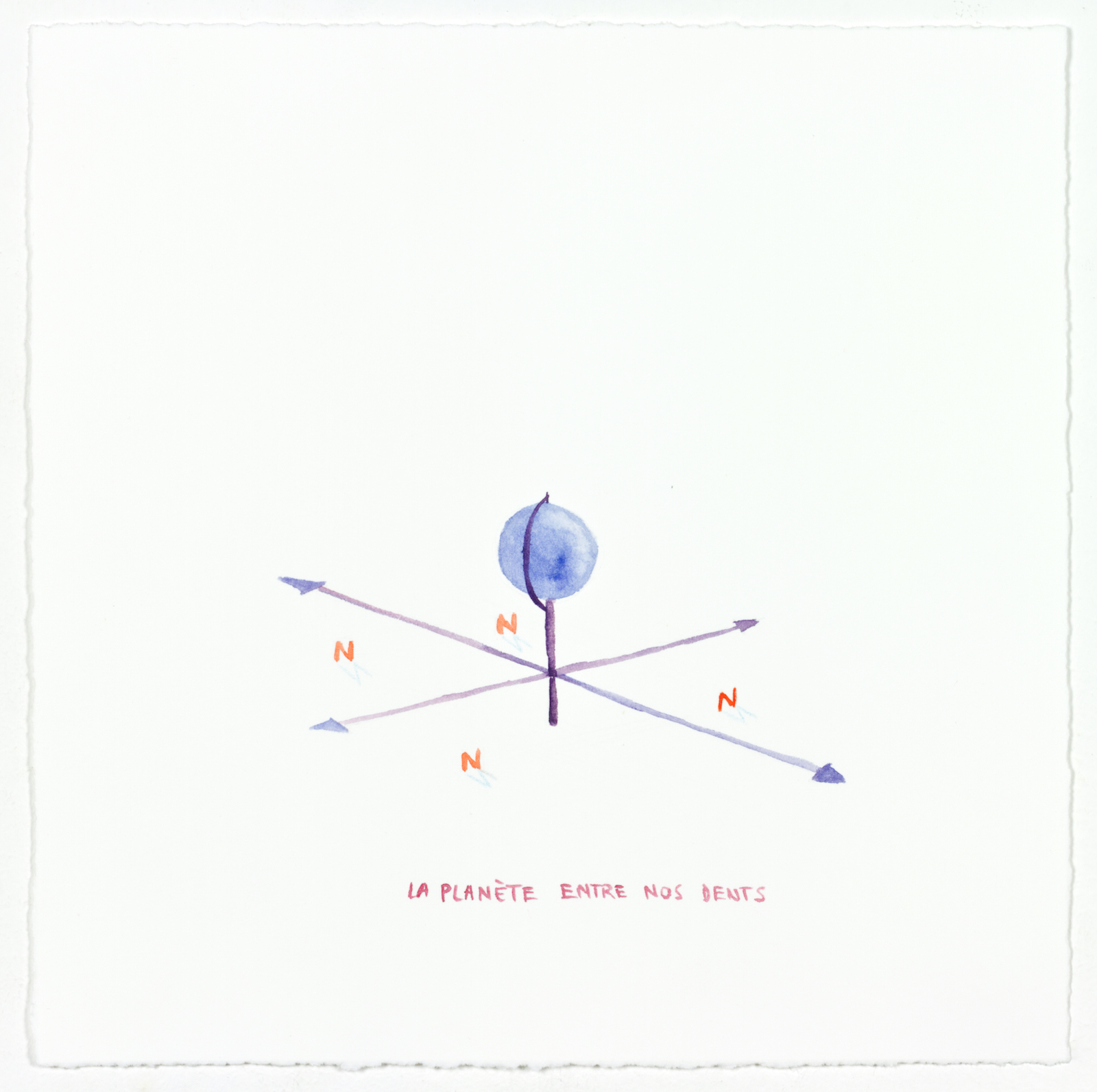
22 x 22 cm
signed at the bottom right of the back
Inspired by Jean Sénac's poems, Massinissa Selmani tries to capture the particular rhythm of the author's writing. He draws fragments with watercolour that echo the language. The sentences are sometimes left as they are, sometimes invented, modified or expanded, while preserving and emphasizing the impertinence and absurdity of the revolutionary poet's words. Far from illustration, Massinissa Selmani focuses mainly on the formal and graphic rhythm to develop a poetry of drawing that is central in his work.
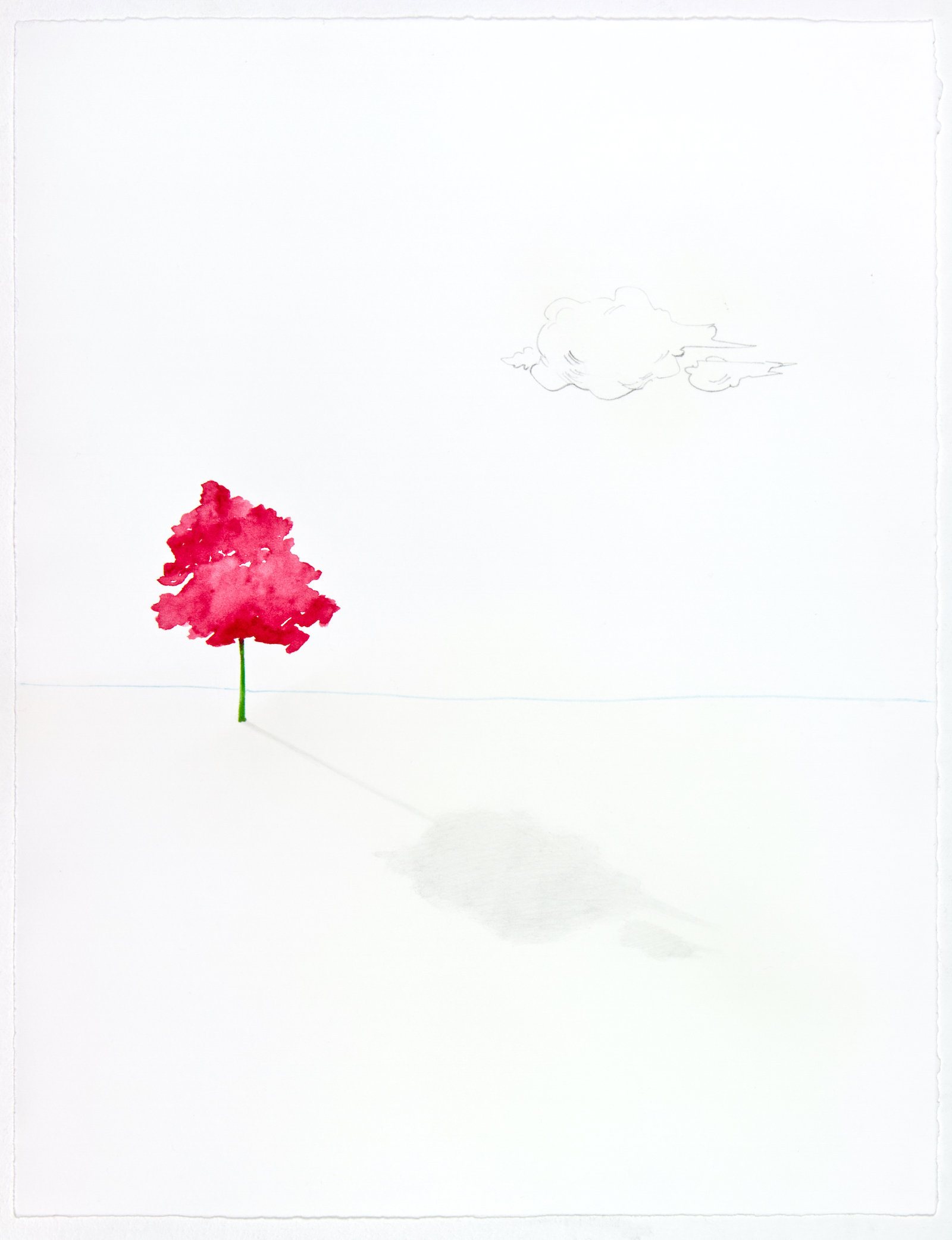
42 x 31 cm
signed at the bottom right of the back
In this drawing, Massinissa Selmani correlates the shadow of an orphaned and coloured tree with the one of a cloud that dominates it.
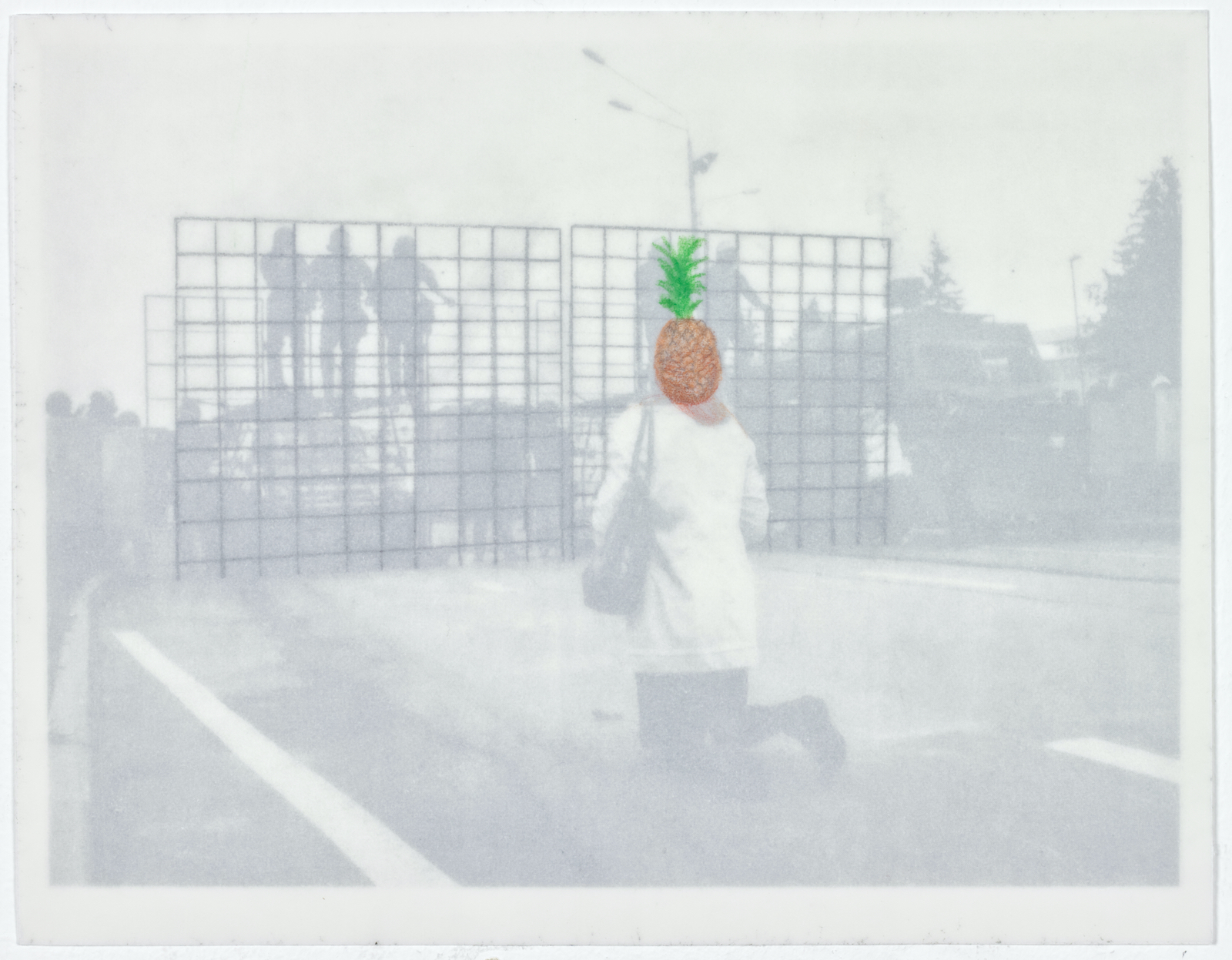
Photocopy, graphite and colour pencils on tracing paper
15,5 x 19,8 cm
Signed on bottom left of the back
Altérables is a long-term project that consists of creating a series of images with the same process: images recovered from newspapers are photocopied and then retouched by using one or more layers of transparent tracing paper. On each layer, a drawing comes duplicate, move or add an element or a contour of the original image. The transformed image is thus 'altered' and put into a different context, opening up the field of interpretation and diverting the original meaning of the source-image.
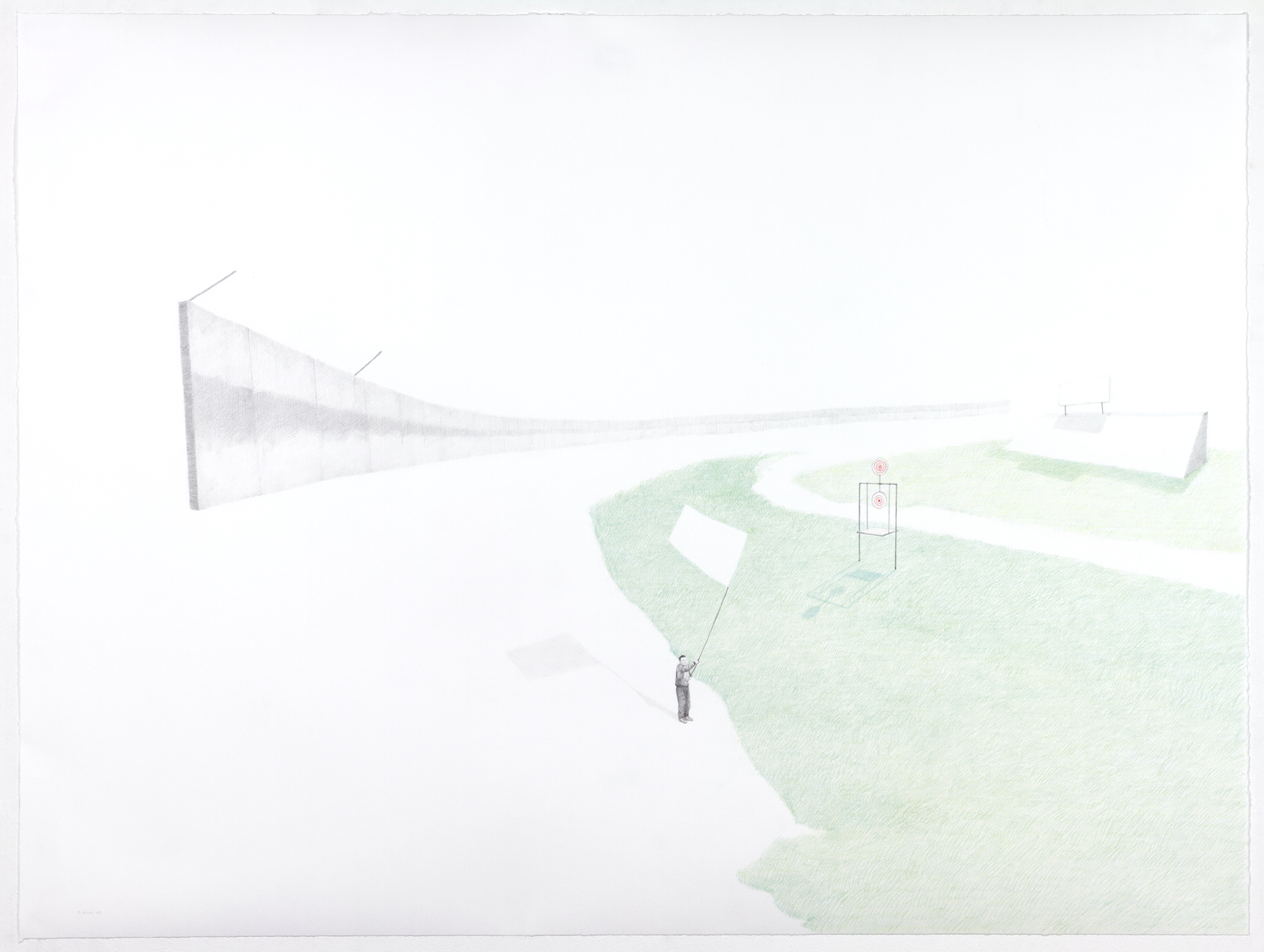
75 x 100 cm
signed at the bottom left
The series Aubes insondables represents an evolution in the work of Massinissa Selmani. Here, the artist is interested in the forms' suggestion through a play on space and values. Although his sources of inspiration deflect from the written press, these works are nevertheless in line with his reflection of designing enigmatic, floating and imaginary spaces. He conceives environments, in an "unfathomable" style as the title suggests, without beginning or end, accentuating the mystery of floating scenes and architectures.
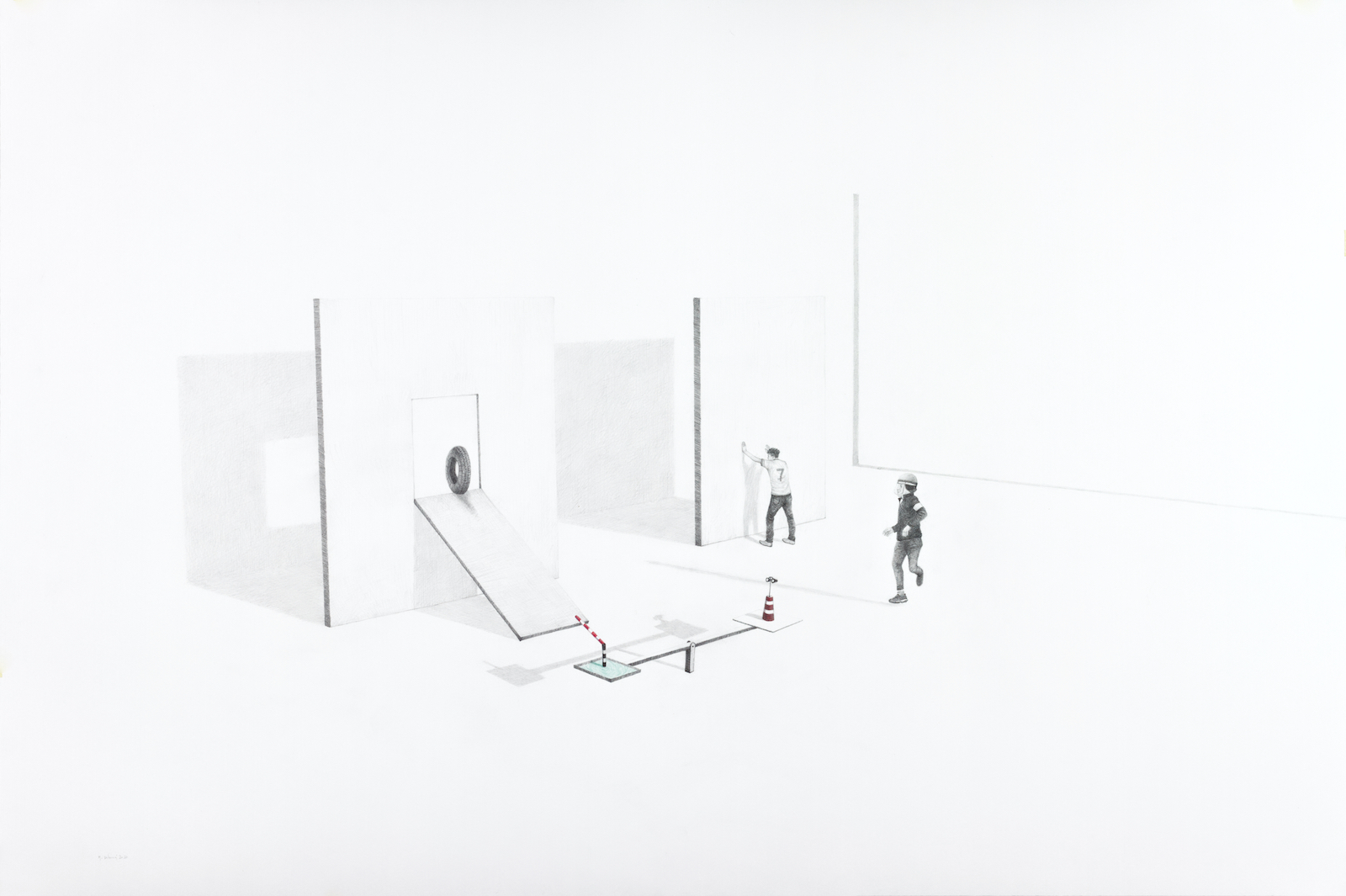
65 x 97,5 cm
Signed at the bottom left
Prélude de l'élan visible series has been inspired by the artist, after he was marked by the recent accounts of violence and arrests. Massinissa Selmani wanted to translate this use of excessive physical and institutional force. Nevertheless, he does not aim here to describe a specific action or event, but rather a situation in which the violence of authority is played out in the face of its being challenged through various forms of protest (resistance, opinions, the unbolting of statues, etc.). He thus offers a subjective reading of so-called "legitimate" physical violence by focusing more on its structural and unfathomable part rather than its contextual one.
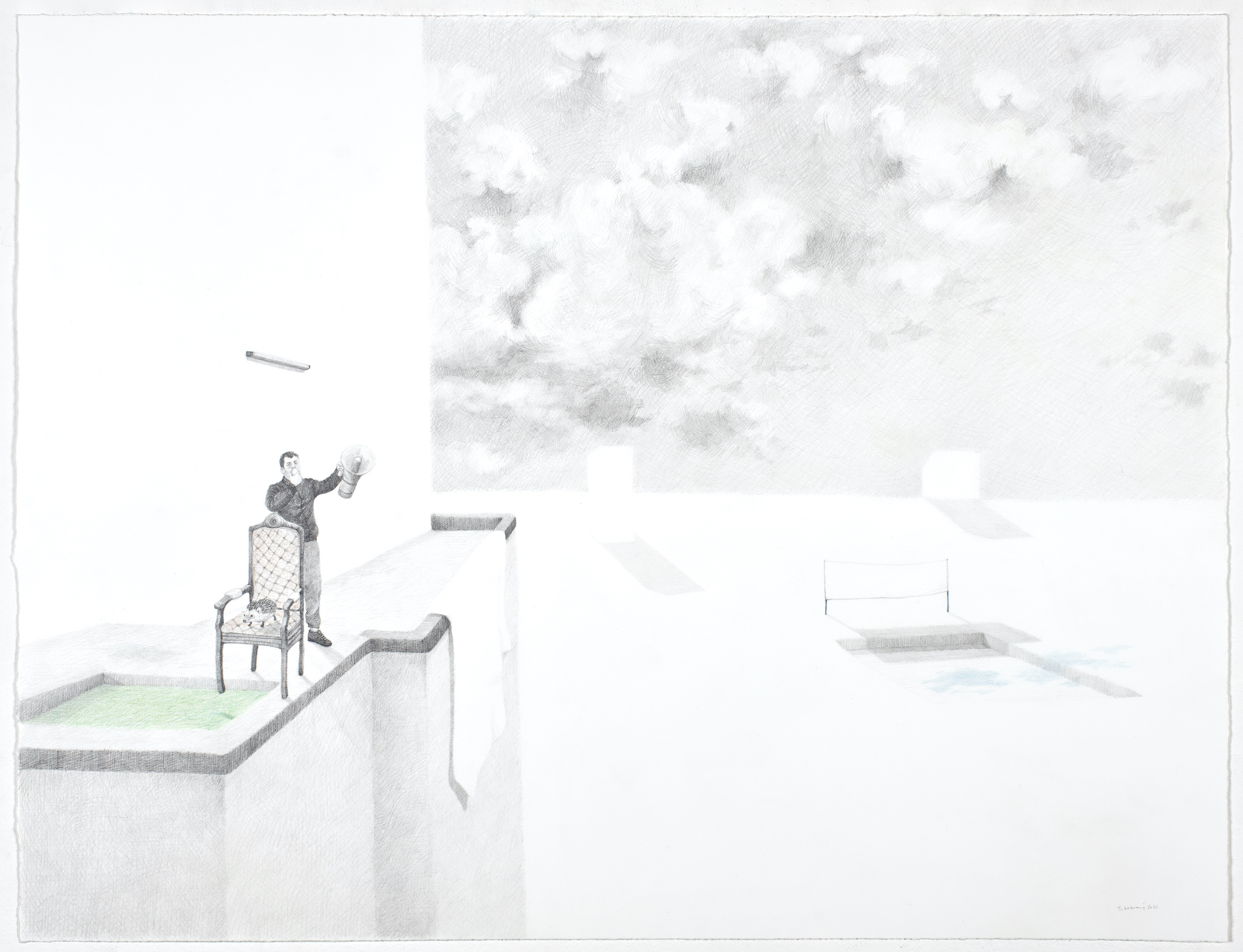
50 x 65 cm
signed at the bottom right
The series Aubes insondables represents an evolution in the work of Massinissa Selmani. Here, the artist is interested in the forms' suggestion through a play on space and values. Although his sources of inspiration deflect from the written press, these works are nevertheless in line with his reflection of designing enigmatic, floating and imaginary spaces. He conceives environments, in an "unfathomable" style as the title suggests, without beginning or end, accentuating the mystery of floating scenes and architectures.
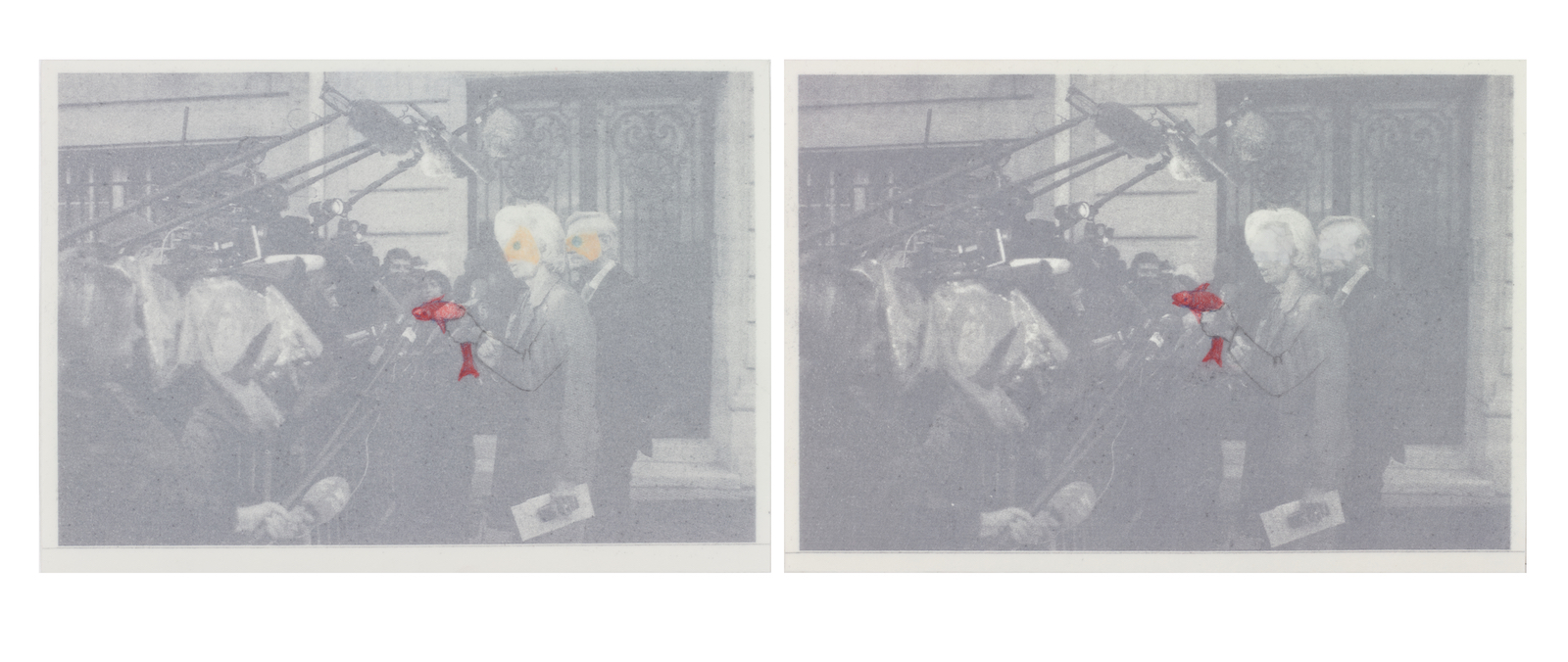
Photocopy, graphite and colour pencils on tracing paper, adhesive - diptych
10,3 x 14,7 cm (each)
Signed on bottom left of the back
Altérables is a long-term project that consists of creating a series of images with the same process: images recovered from newspapers are photocopied and then retouched by using one or more layers of transparent tracing paper. On each layer, a drawing comes duplicate, move or add an element or a contour of the original image. The transformed image is thus 'altered' and put into a different context, opening up the field of interpretation and diverting the original meaning of the source-image.
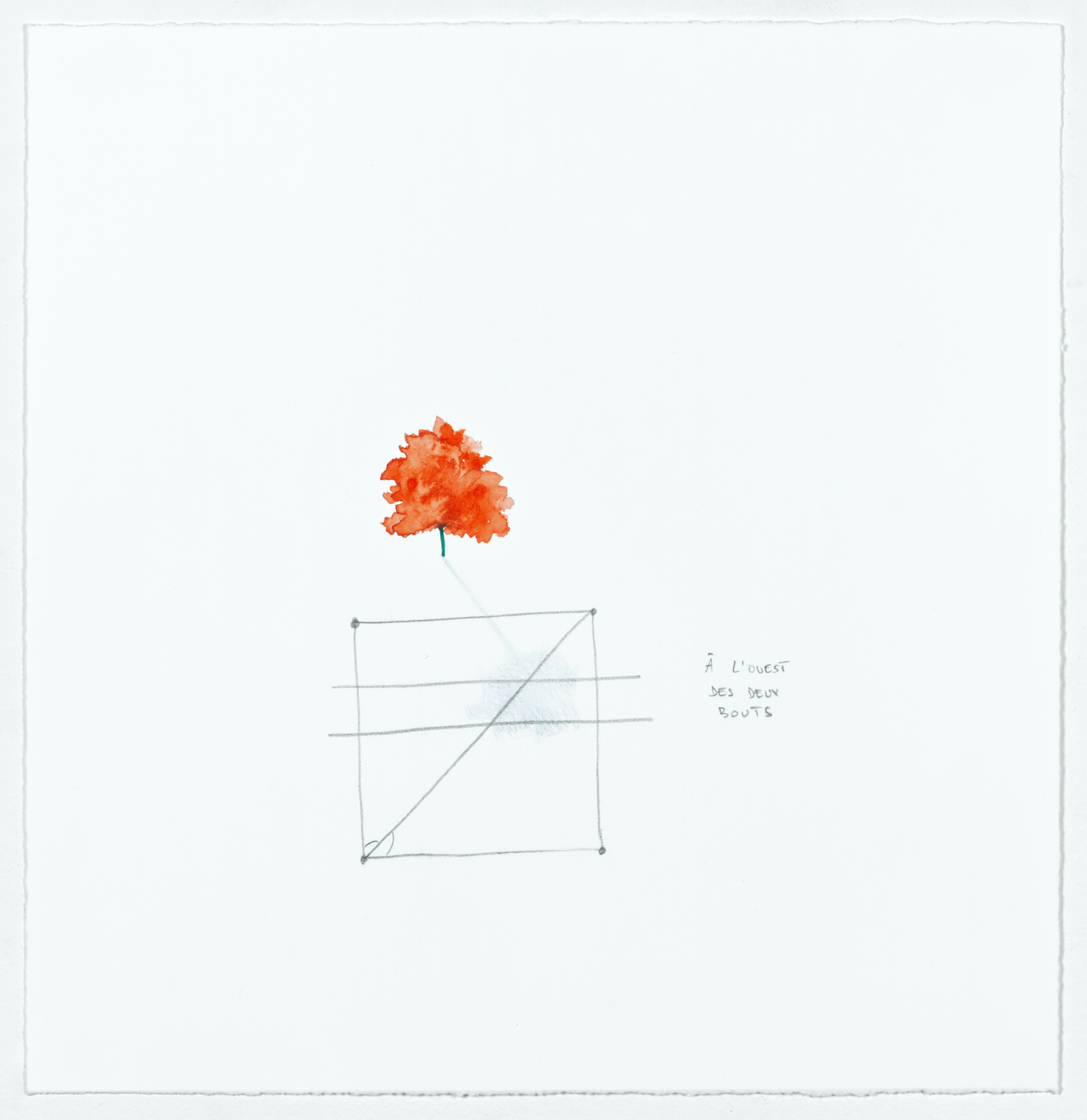
31 x 30 cm
signed at the bottom right of the back
Inspired by Jean Sénac's poems, Massinissa Selmani tries to capture the particular rhythm of the author's writing. He draws fragments with watercolour that echo the language. The sentences are sometimes left as they are, sometimes invented, modified or expanded, while preserving and emphasizing the impertinence and absurdity of the revolutionary poet's words. Far from illustration, Massinissa Selmani focuses mainly on the formal and graphic rhythm to develop a poetry of drawing that is central in his work.

50 x 65 cm
Signed at the bottom right
Prélude de l'élan visible series has been inspired by the artist, after he was marked by the recent accounts of violence and arrests. Massinissa Selmani wanted to translate this use of excessive physical and institutional force. Nevertheless, he does not aim here to describe a specific action or event, but rather a situation in which the violence of authority is played out in the face of its being challenged through various forms of protest (resistance, opinions, the unbolting of statues, etc.). He thus offers a subjective reading of so-called "legitimate" physical violence by focusing more on its structural and unfathomable part rather than its contextual one.
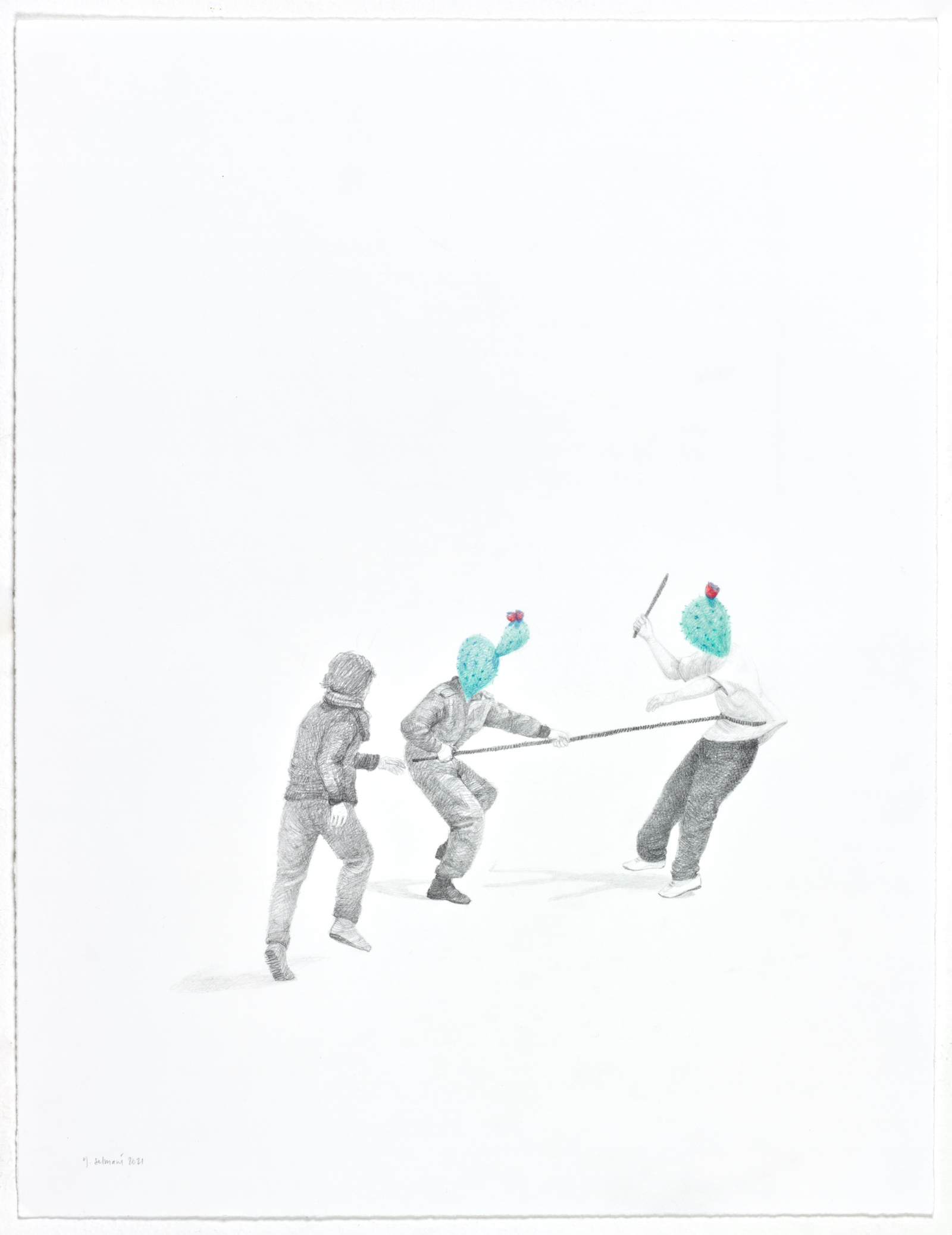
32,5 x 25 cm
Signed at the bottom left
In 3 jours de travail, Massinissa Selmani depicts an scene without decor, occupied by three characters with anonymised faces, emphasising their movement all the more. The uniform of one of them suggests a position of power in relation to the other two, reminiscent of the images of arrests that feed the news. However, the artist does not wish to refer to a specific situation, and inserts enigmatic elements, such as this long metal rod that keeps the distance or these cacti in place of the faces. These associations induce a disturbing strangeness, between comic absurdity and fright.
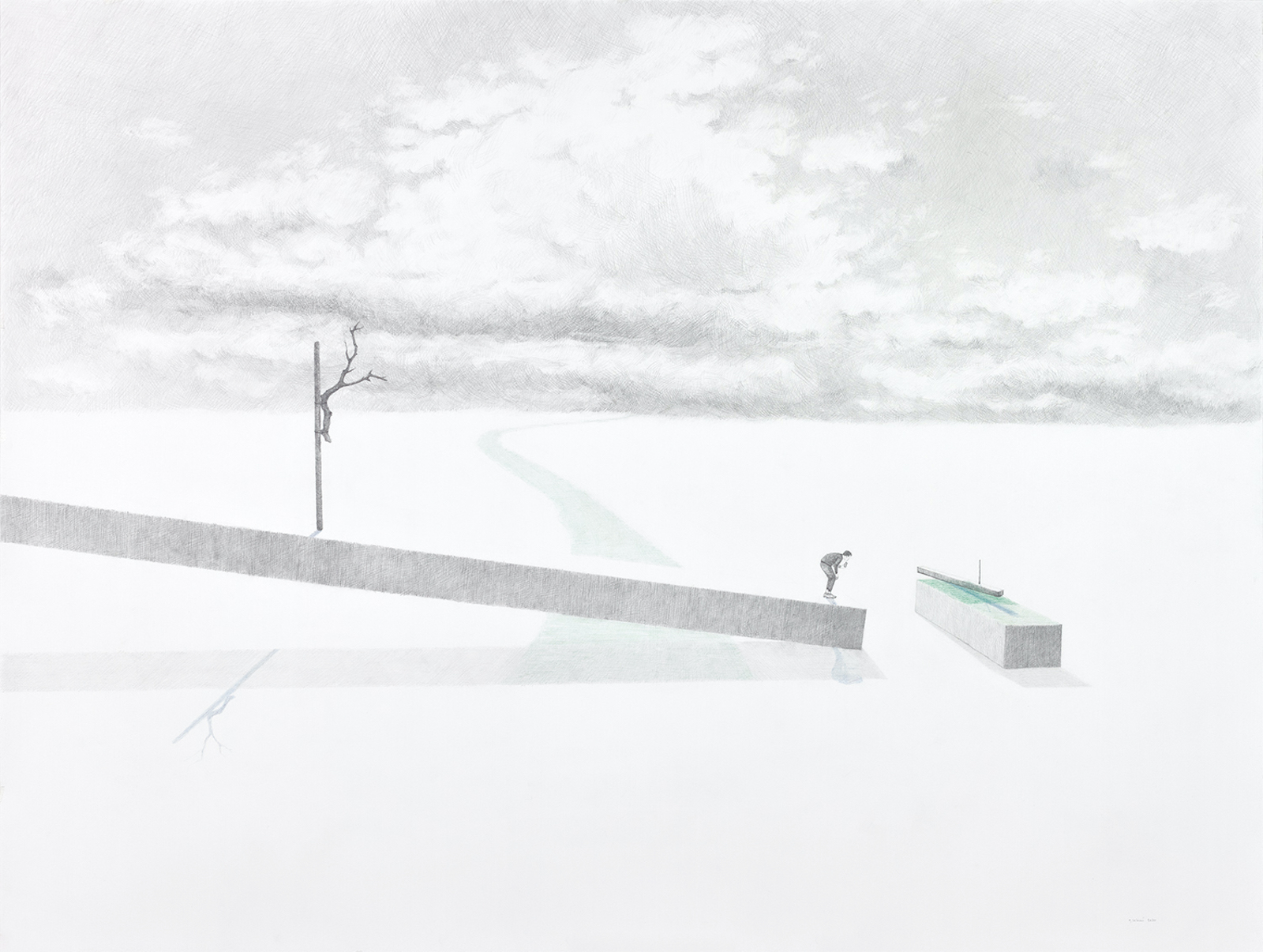
75 x 100 cm
Signed and dated lower right
The series Aubes insondables represents an evolution in the work of Massinissa Selmani. Here, the artist is interested in the forms's suggestion through a play on space and values. Although his sources of inspiration deflect from the written press, these works are nevertheless in line with his reflection of designing enigmatic, floating and imaginary spaces. He conceives environments, in an "unfathomable" style as the title suggests, without beginning or end, accentuating the mystery of floating scenes and architectures.
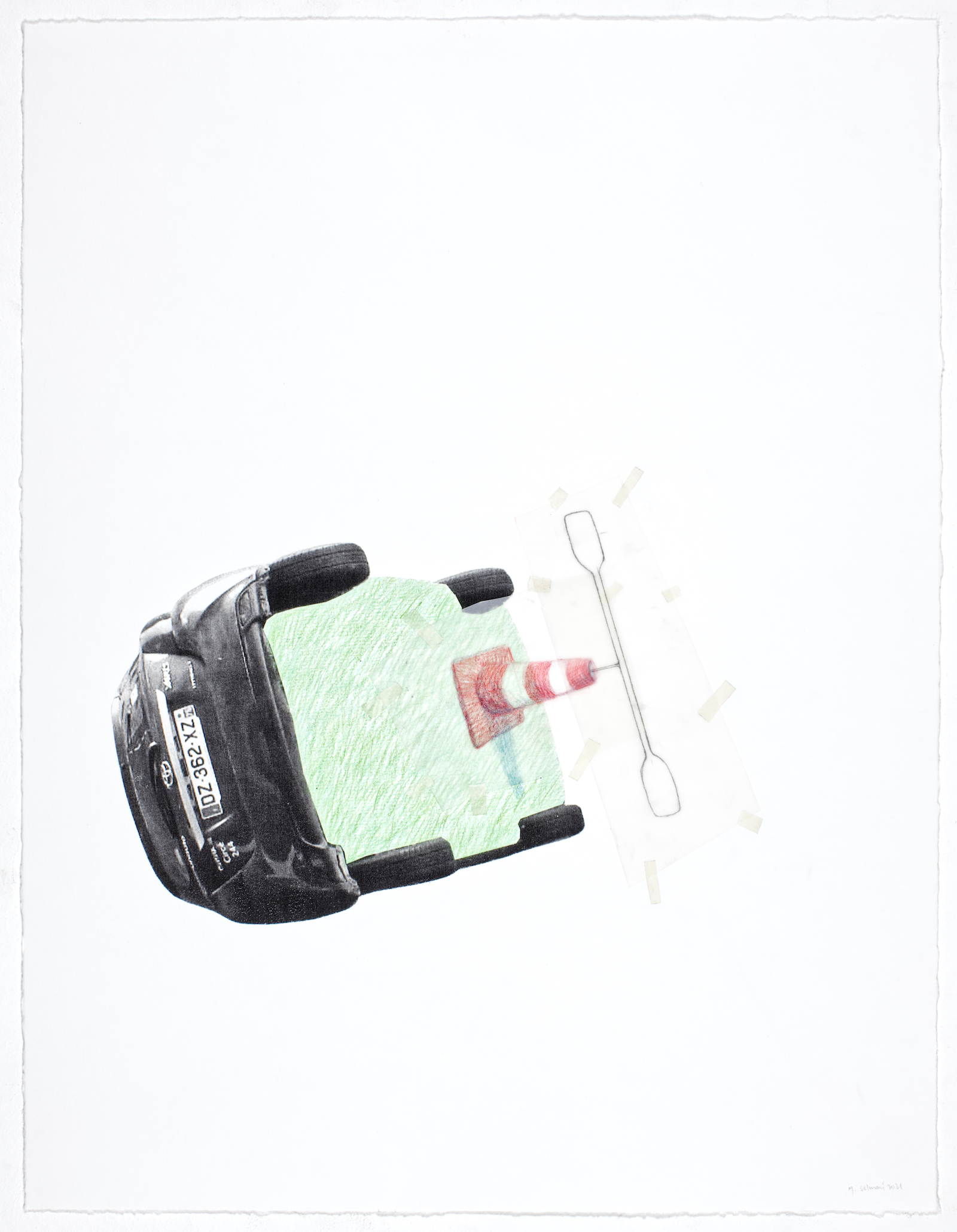
Coloured pencil on photocopy, Graphite and coloured pencils on tracing paper, adhesive
50 x 38,5 cm
signed at the bottom right
The series Après l'ordinaire (After the Ordinary) is rooted in the media imaginary of the political demonstrations and riots that have made the news in recent months. From the carcasses of burnt or overturned ordinary and police's cars that he takes from the press and photocopies, Massinissa Selmani reinterprets the ruins of violence by associating them with incongruous elements (hunting trophies, rocks, etc.). The latter seem to create a balance with this violence that they defuse, thus forming territories of conflict tinged with a mystical, even disturbing banality. Moreover, through the intrusion of formal geometric elements and the multiplication of points of view in the five variations of Après l'ordinaire, the artist pursues his reflection on altered images and the documentation of events through drawing.
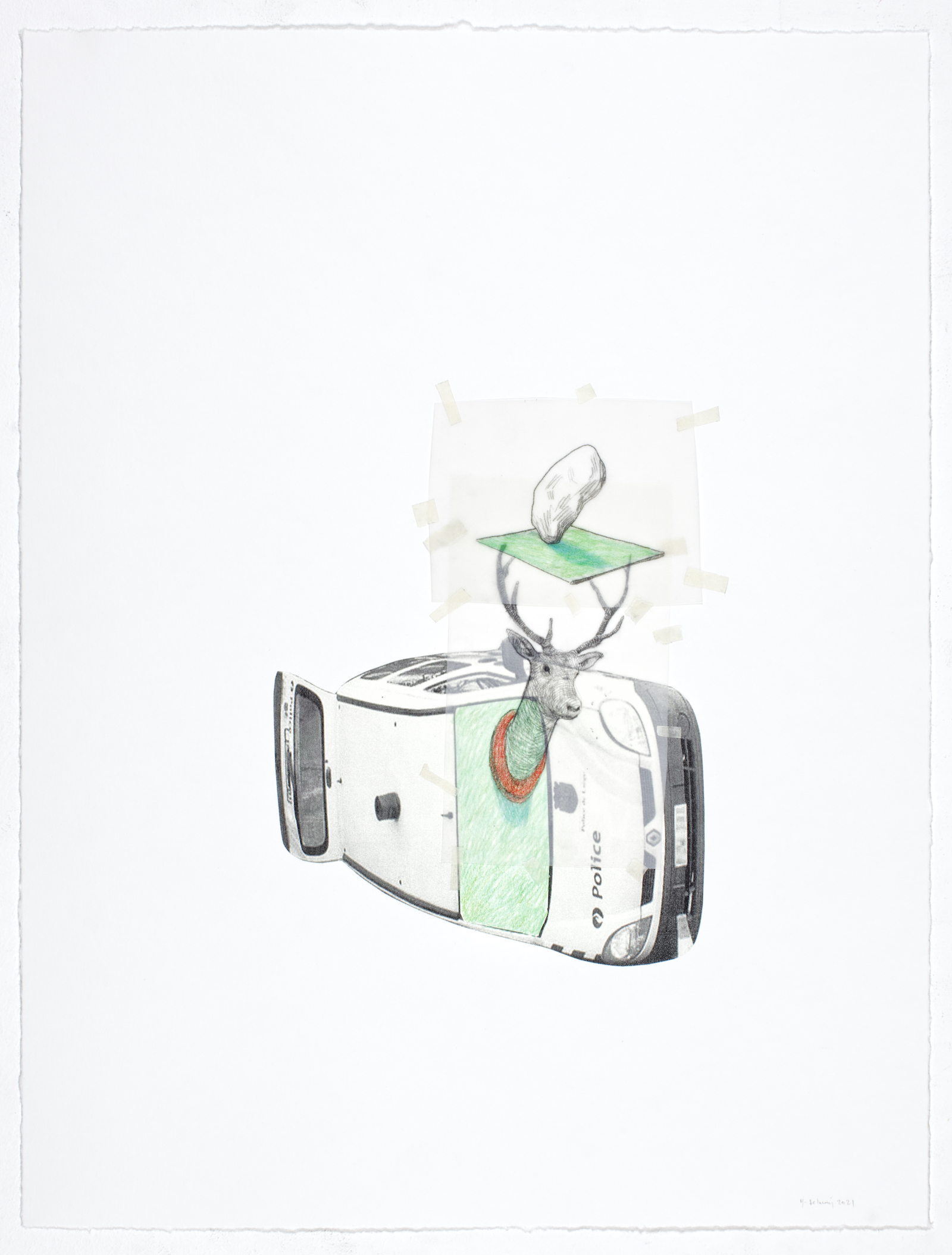
Coloured pencil on photocopy, Graphite and coloured pencils on tracing paper, adhesive
50 x 38,5 cm
signed at the bottom right
The series Après l'ordinaire (After the Ordinary) is rooted in the media imaginary of the political demonstrations and riots that have made the news in recent months. From the carcasses of burnt or overturned ordinary and police's cars that he takes from the press and photocopies, Massinissa Selmani reinterprets the ruins of violence by associating them with incongruous elements (hunting trophies, turtles, wheels, rocks, etc.). The latter seem to create a balance with this violence that they defuse, thus forming territories of conflict tinged with a mystical, even disturbing banality. Moreover, through the intrusion of formal geometric elements and the multiplication of points of view in the five variations of Après l'ordinaire, the artist pursues his reflection on altered images and the documentation of events through drawing.
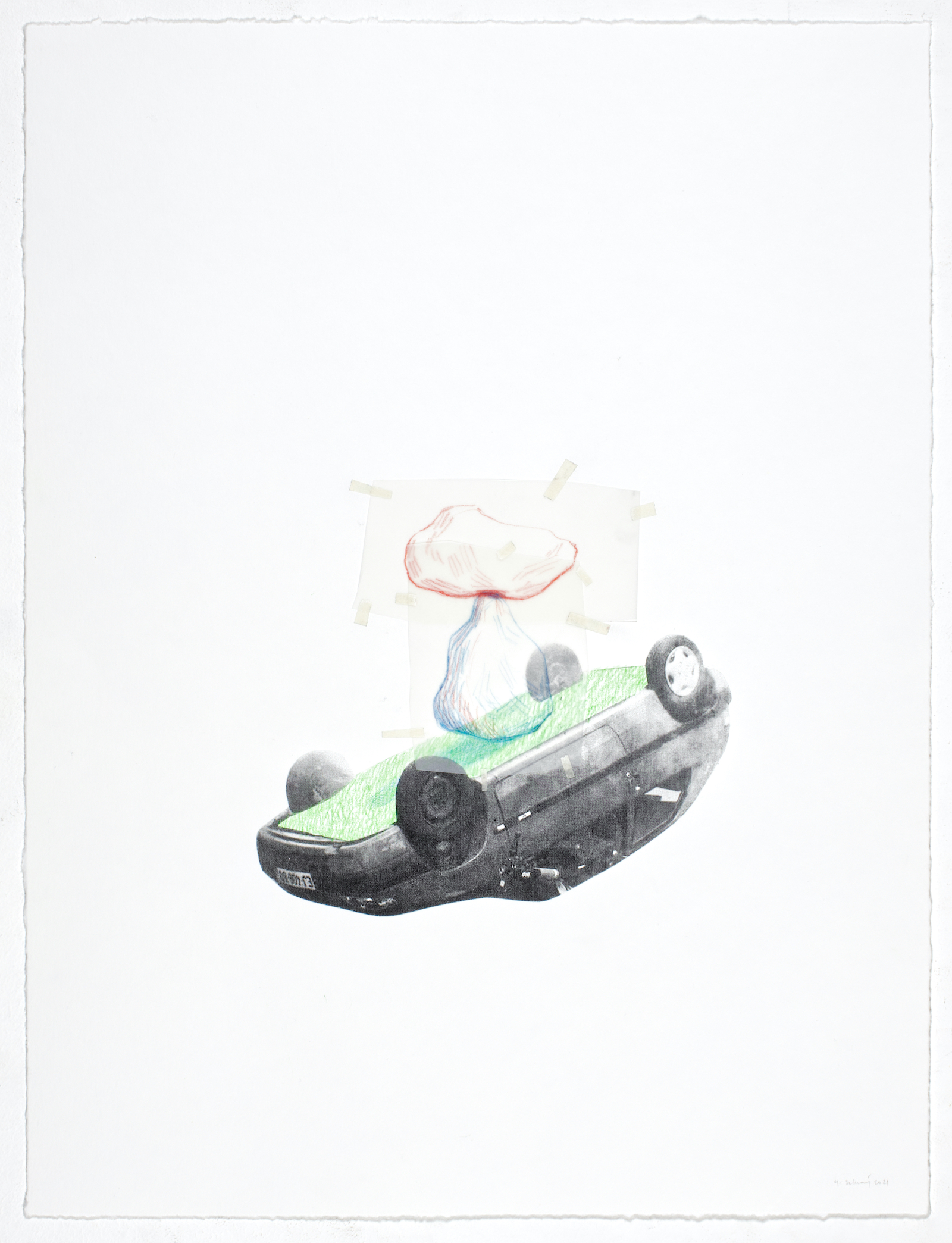
Coloured pencil on photocopy, Graphite and coloured pencils on tracing paper, adhesive
50 x 38,5 cm
signed at the bottom right
The series Après l'ordinaire (After the Ordinary) is rooted in the media imaginary of the political demonstrations and riots that have made the news in recent months. From the carcasses of burnt or overturned ordinary and police's cars that he takes from the press and photocopies, Massinissa Selmani reinterprets the ruins of violence by associating them with incongruous elements (hunting trophies, turtles, wheels, rocks, etc.). The latter seem to create a balance with this violence that they defuse, thus forming territories of conflict tinged with a mystical, even disturbing banality. Moreover, through the intrusion of formal geometric elements and the multiplication of points of view in the five variations of Après l'ordinaire, the artist pursues his reflection on altered images and the documentation of events through drawing.
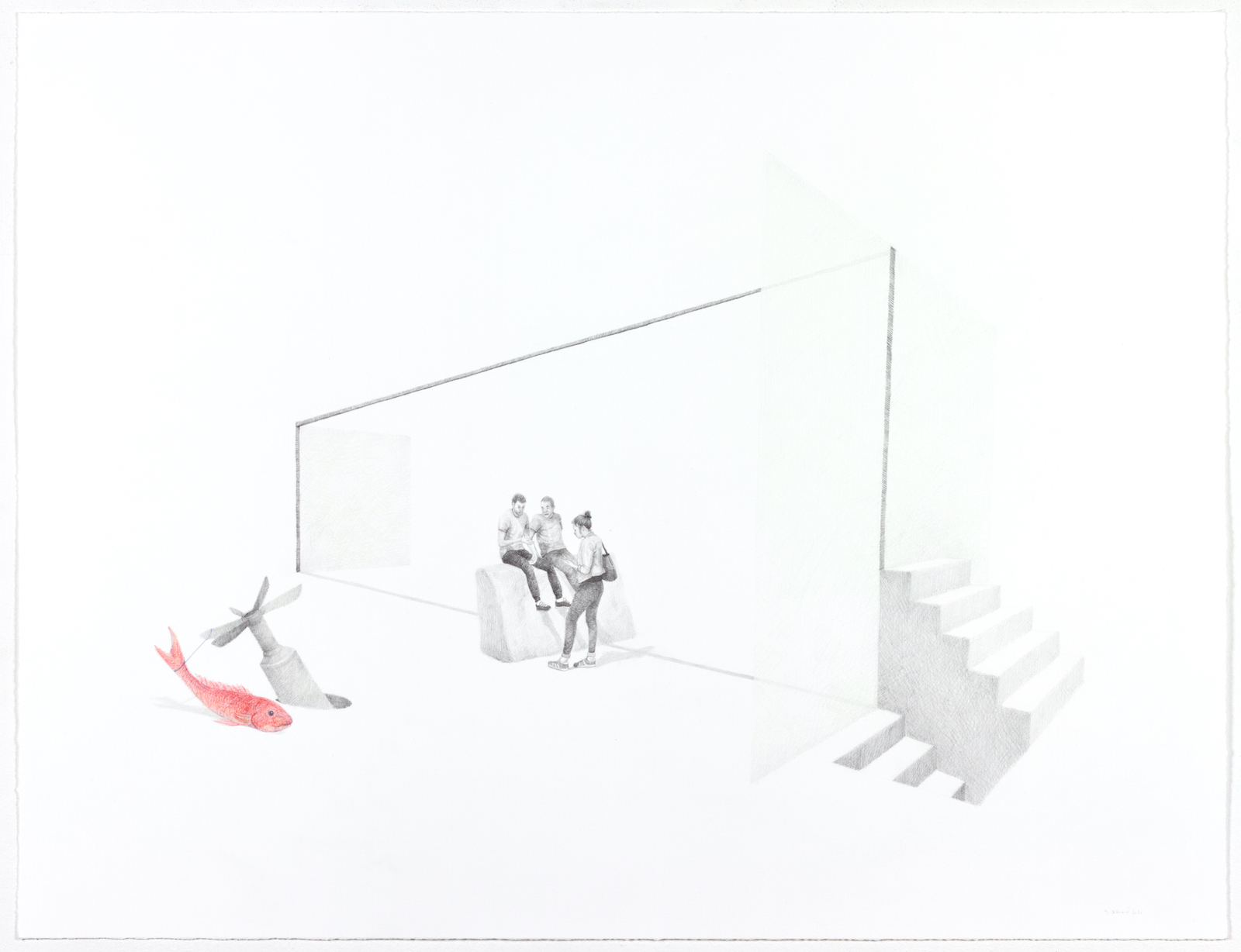
50 x 65 cm
Signed at the bottom right
In Une architecture sur le versant du cratère, Massinissa Selmani concieves a situation taking place in an imaginary and fantastic space, that resembles a theatre stage. In an enigmatic tone, the artist amuses himself by imagining architectural structures in which he assembles composite elements, leaving the viewer free to project his own relational patterns. The title, taken from a poem by Jean Sénac, comes as an additional element to those drawn, opening up other possibilities of interpretation.
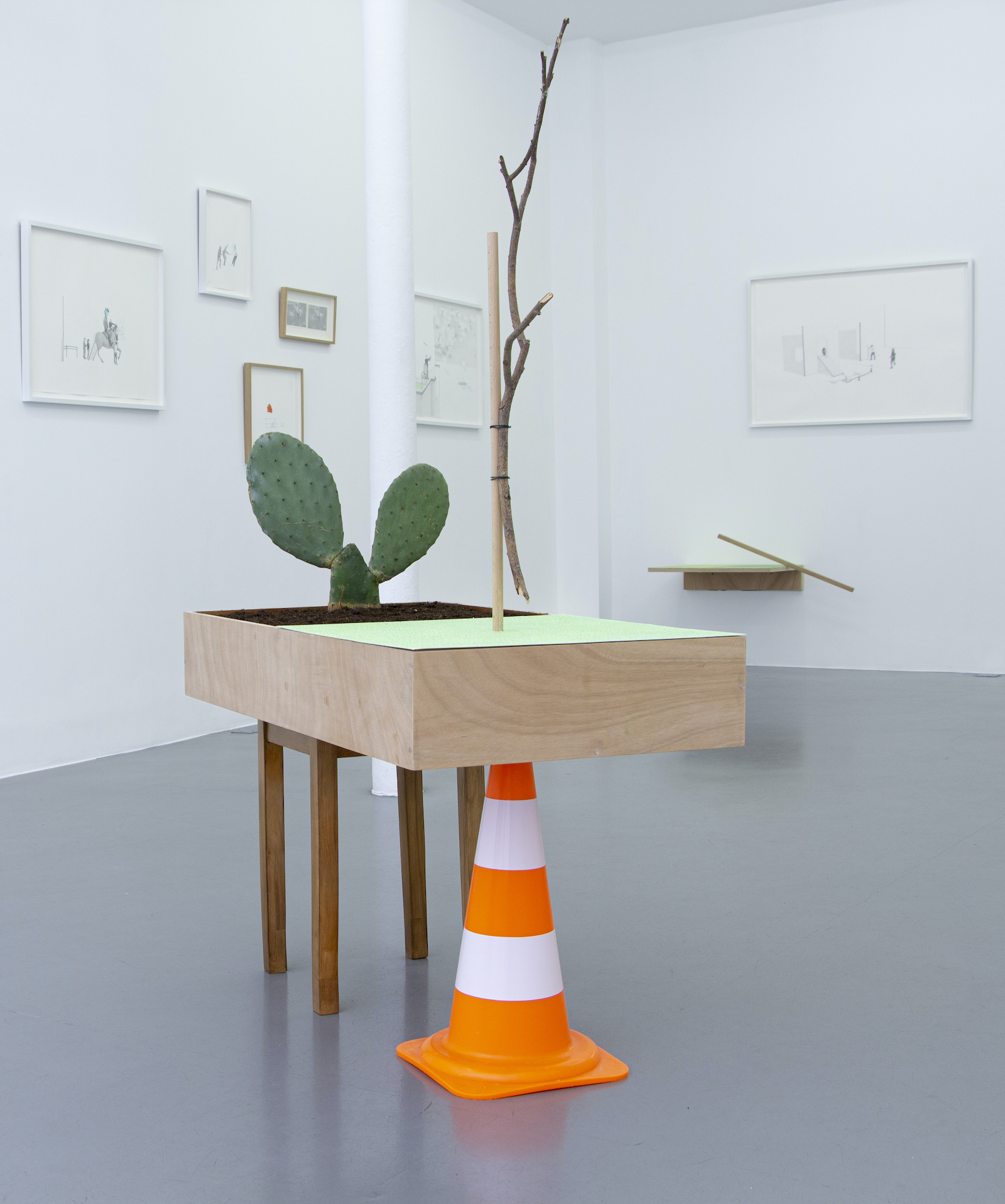
151 x 50 x 15 cm
The sculptures scattered throughout the exhibition are reuses and diversions of objects from urban signage or from everyday life (binoculars, stools, cacti). They bring a new insight to the drawings by materialising elements straight out of Massinissa Selmani's compositions. The artist conceives the landscape as a territory of conflict, at once oneiric and surreal, tragic and absurd, made up of balances and confrontations. The installations are imagined as a mirror image of the watercolours, particularly through the titles. Indeed, the titles, taken from Paul Nougé's poems, shed new light on the works while establishing a dialogue with the spirit of Jean Sénac's poetry which gives the watercolours their titles.
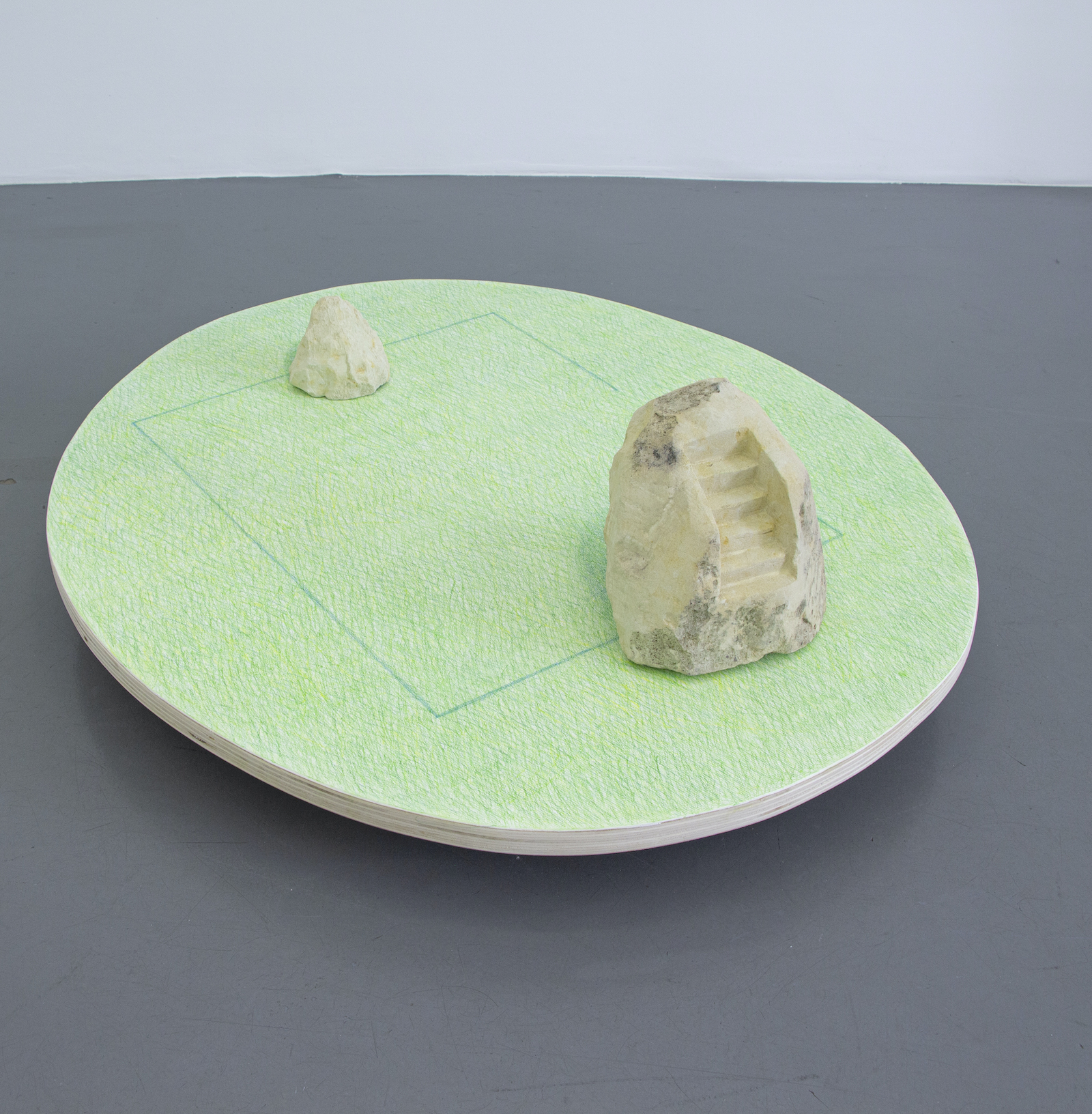
29,5 x 87 x 75,5 cm
The sculptures scattered throughout the exhibition are reuses and diversions of objects from urban signage or from everyday life (binoculars, stools, cacti). They bring a new insight to the drawings by materialising elements straight out of Massinissa Selmani's compositions. The artist conceives the landscape as a territory of conflict, at once oneiric and surreal, tragic and absurd, made up of balances and confrontations. The installations are imagined as a mirror image of the watercolours, particularly through the titles. Indeed, the titles, taken from Paul Nougé's poems, shed new light on the works while establishing a dialogue with the spirit of Jean Sénac's poetry which gives the watercolours their titles.

28,5 x 69 x 28,5 cm
The sculptures scattered throughout the exhibition are reuses and diversions of objects from urban signage or from everyday life (binoculars, stools, cacti). They bring a new insight to the drawings by materialising elements straight out of Massinissa Selmani's compositions. The artist conceives the landscape as a territory of conflict, at once oneiric and surreal, tragic and absurd, made up of balances and confrontations. The installations are imagined as a mirror image of the watercolours, particularly through the titles. Indeed, the titles, taken from Paul Nougé's poems, shed new light on the works while establishing a dialogue with the spirit of Jean Sénac's poetry which gives the watercolours their titles.
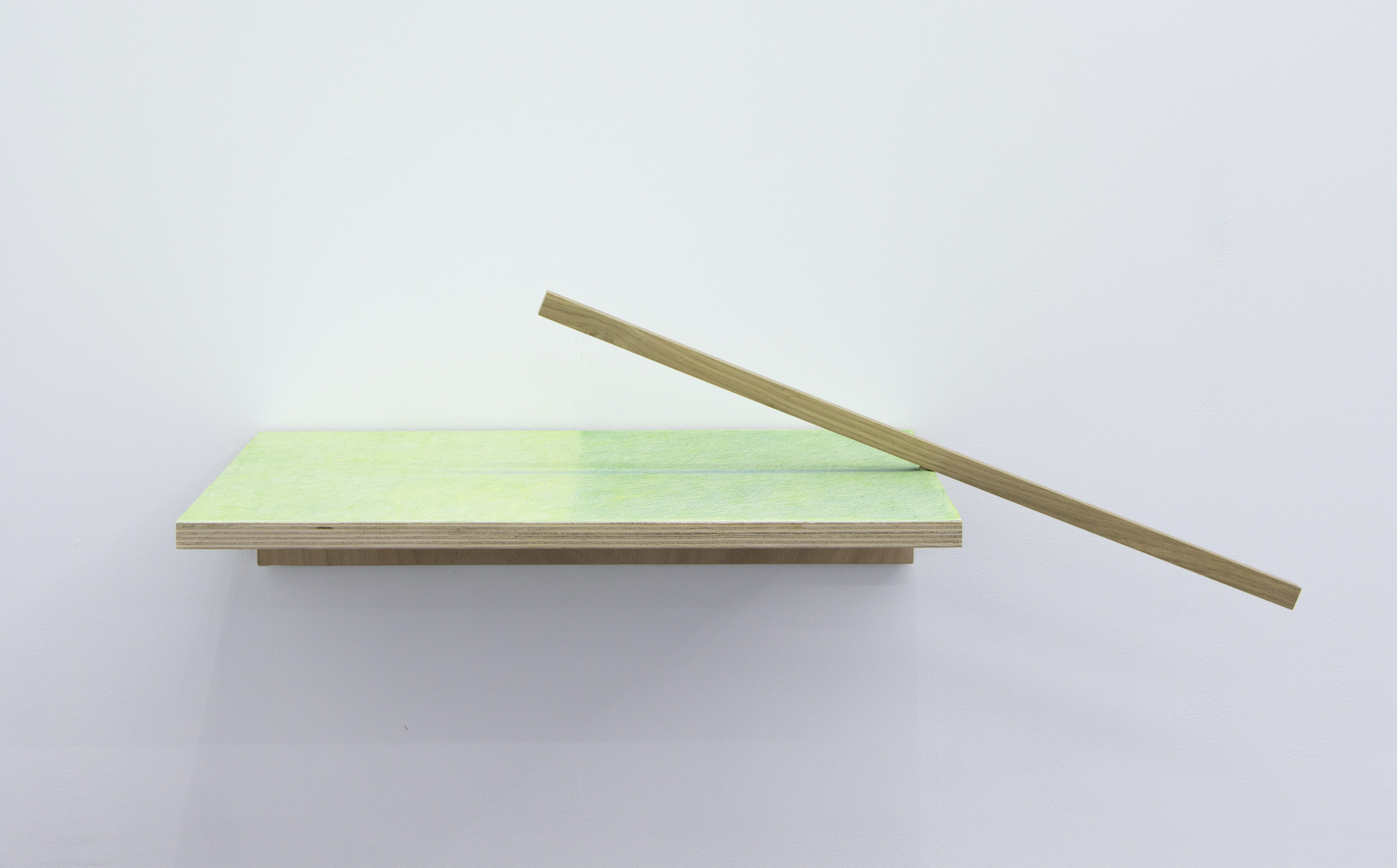
25 x 91 x 45 cm
The sculptures scattered throughout the exhibition are reuses and diversions of objects from urban signage or from everyday life (binoculars, stools, cacti). They bring a new insight to the drawings by materialising elements straight out of Massinissa Selmani's compositions. The artist conceives the landscape as a territory of conflict, at once oneiric and surreal, tragic and absurd, made up of balances and confrontations. The installations are imagined as a mirror image of the watercolours, particularly through the titles. Indeed, the titles, taken from Paul Nougé's poems, shed new light on the works while establishing a dialogue with the spirit of Jean Sénac's poetry which gives the watercolours their titles.


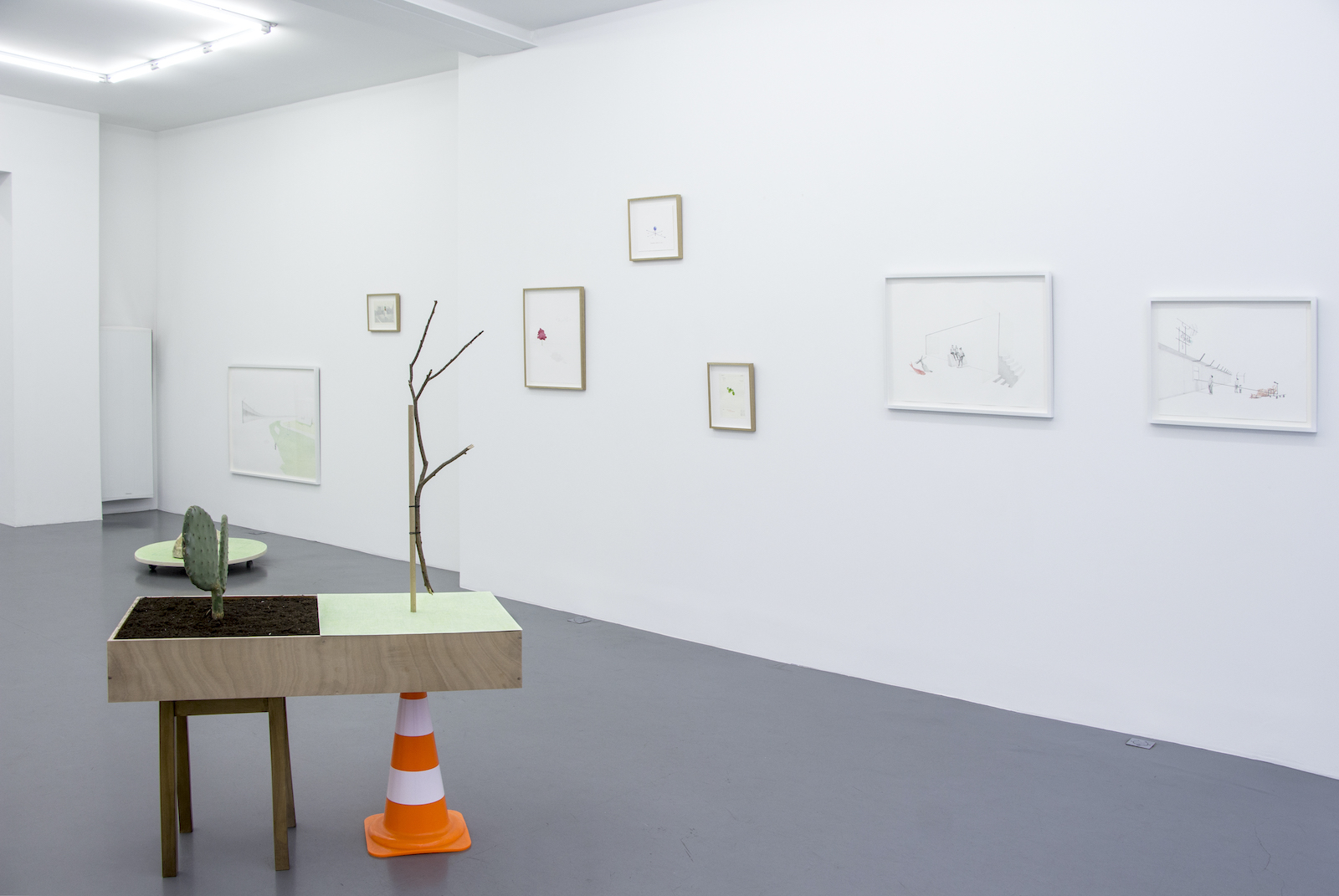
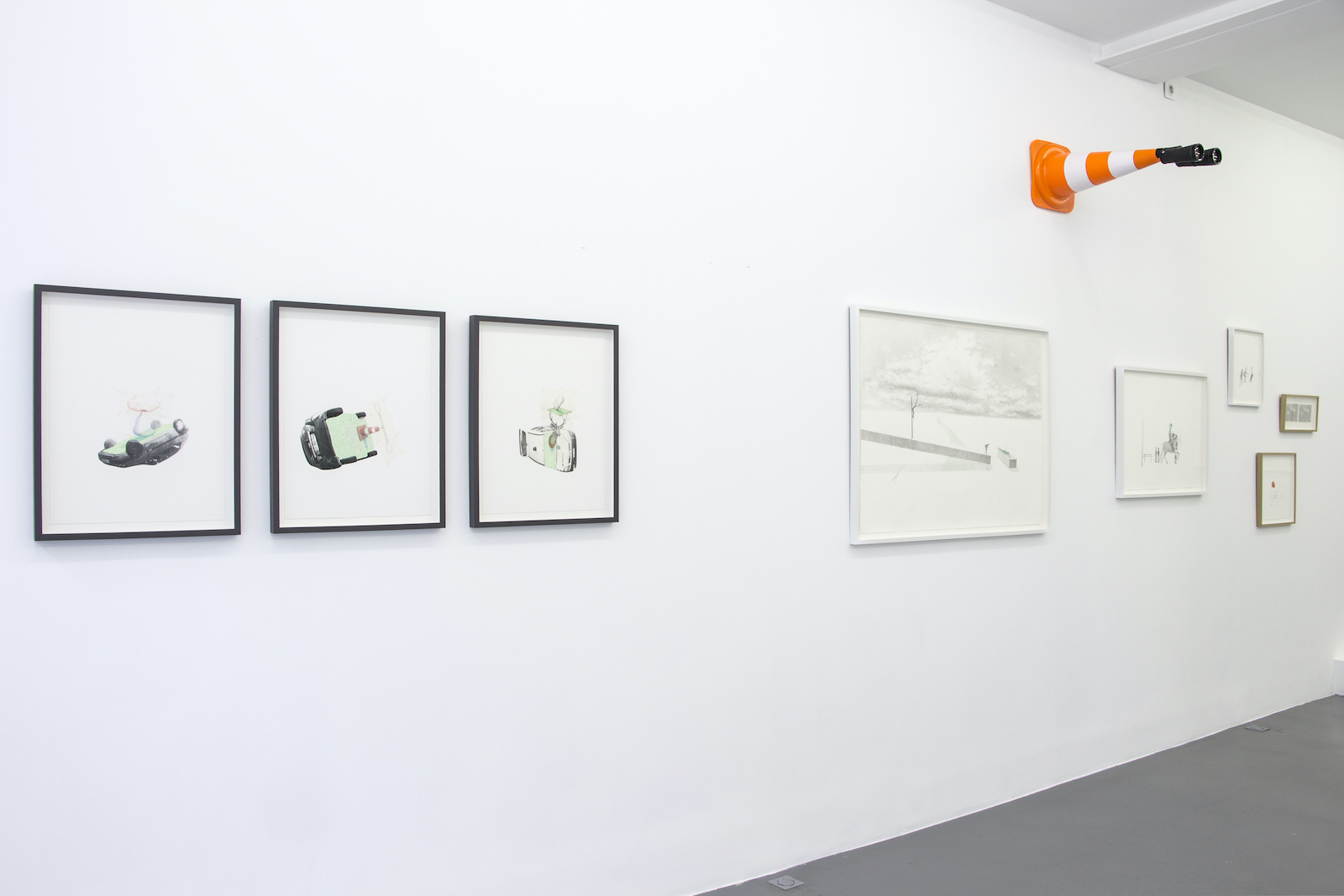
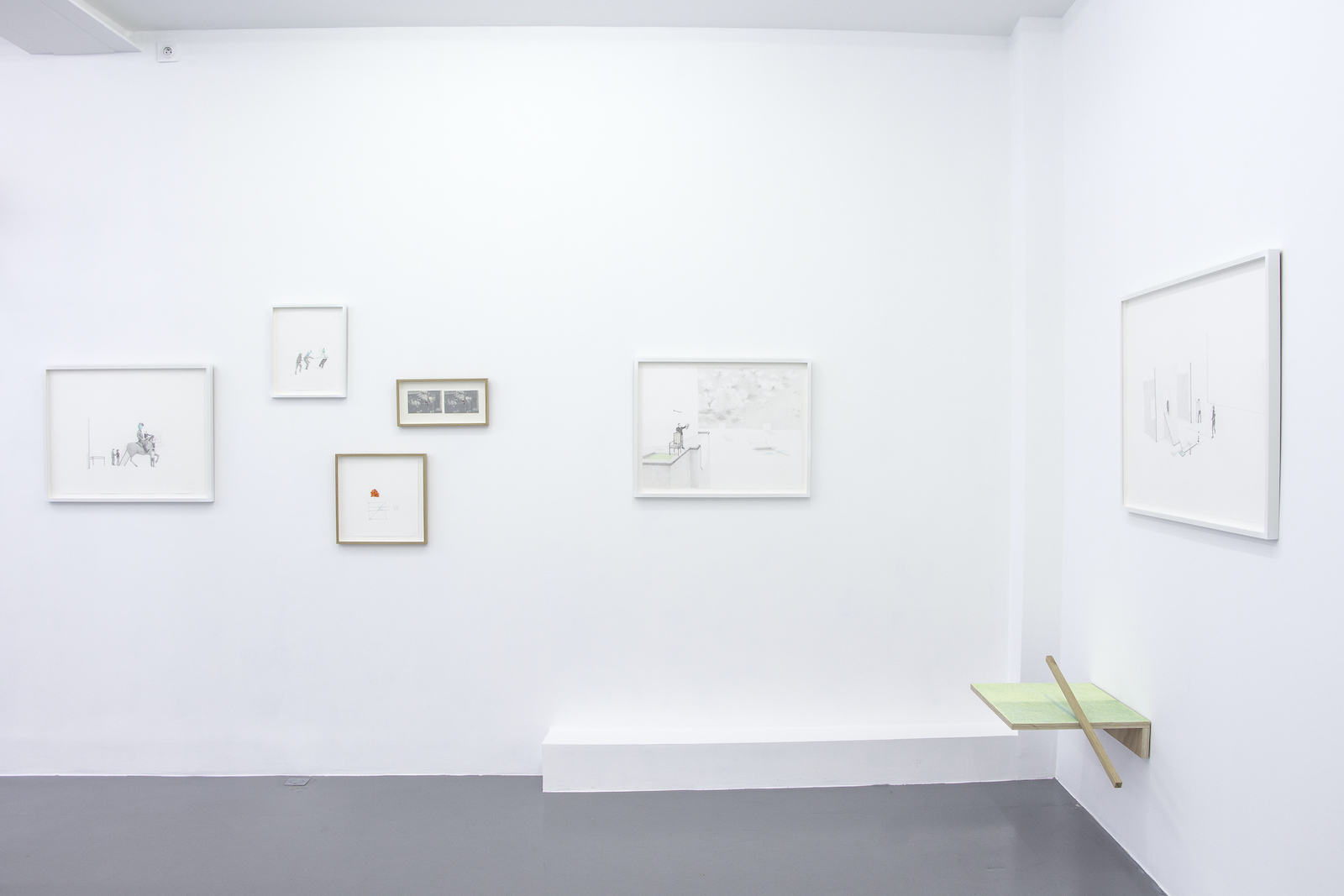

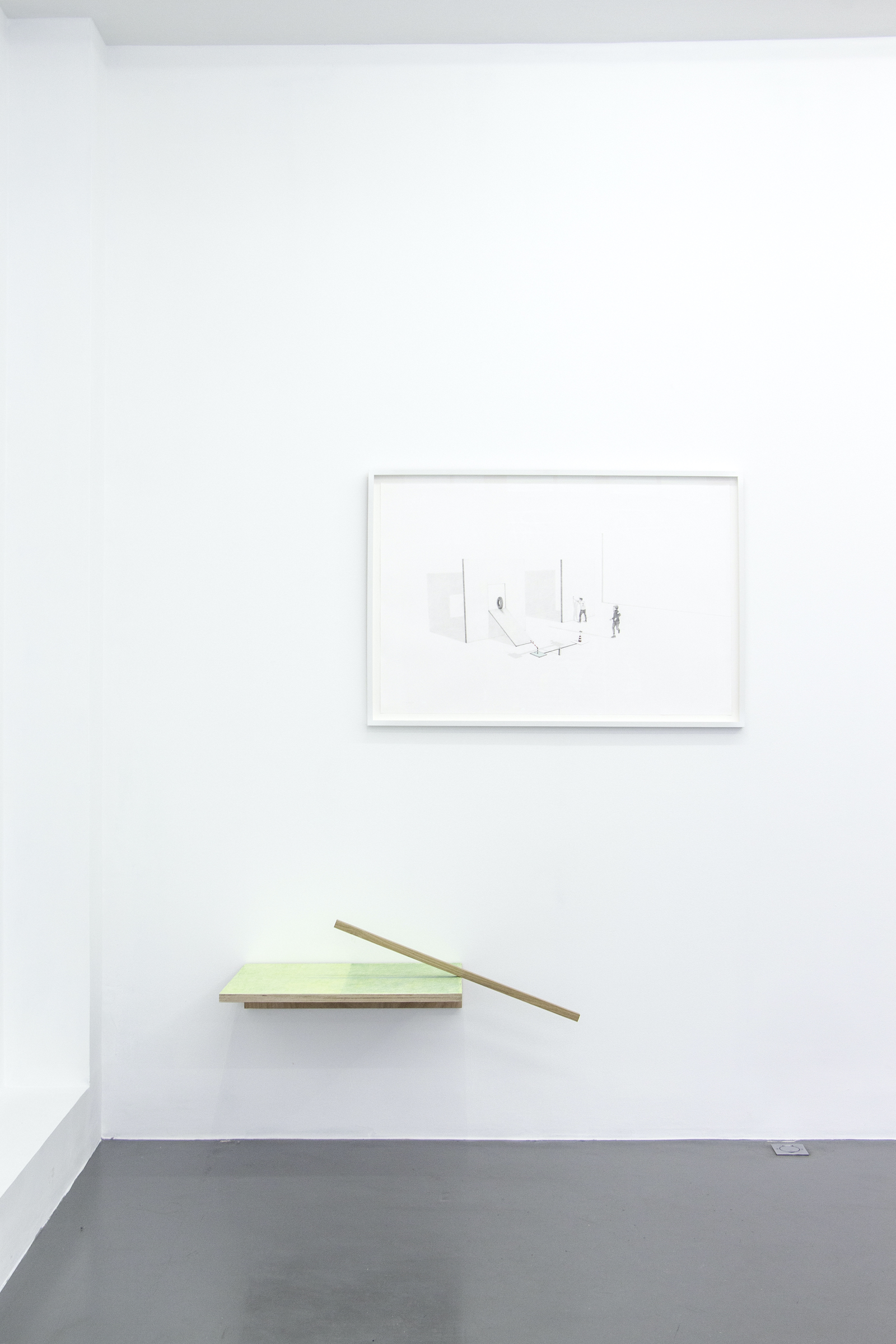

For his second solo show at the gallery, Massinissa Selmani pursues his exploration of themes that are dear to him, around drawing and the absurd, while orienting his work towards new avenues of reflection. For the first time, he presents sculptures that echo the scenes represented in his drawings. Some of his new series take on a more political feature, inspired by recent events and acts of violence. Indeed, the artist's works are constructed from the confrontation and juxtaposition without logical coherence, of real elements that he draws from his collection of press cuttings and imagination. Through this process of drawing that combines documentary form and fiction, the artist highlights the ambiguous and absurd aspect of reality. His works thus subtly divert our perception of images and plays on the border between the real and the unreal.
In homage to the poet Jean Sénac, the title of the exhibition "Rien sinon du rêve au doigt" is borrowed from one of his poems entitled "Trouvure".